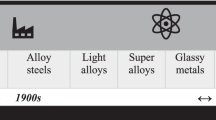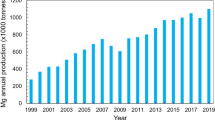Abstract
A summary is presented of recent attempts to model the effects of precipitate shape, orientation, and distribution on yield strength and age-hardening response, using appropriate versions of the Orowan equation and models of precipitation strengthening developed for Al alloys containing a single uniform distribution of rationally oriented plate-or rod-shaped precipitates, which are either shearable or shear resistant. It is demonstrated that these models of particle strengthening are capable of predictions that are in excellent quantitative agreement with experimental observations that high tensile yield strength is associated with microstructures containing a high density of intrinsically strong, plate-shaped precipitates with {111}α or {100}α habit planes and large aspect ratio. The authors predict that further improvement in the strength of existing Al alloys might be achieved by increasing the number density and/or aspect ratio of rationally oriented precipitate plates.
Similar content being viewed by others
Cited References
A.E. Kolmogorov,Akad. Nauk. SSSR, IZV, Ser. Mat, 1, 355 (1937).
M. Avrami,J. Chem Phys., 7, 1103 (1939).
W.A. Johnson and R.F. Mehl,Trans. AIME, 135, 416 (1939).
E. Orowan,Symposium on Internal Stresses in Metals and Alloys, Institute of Metals, London, 451 (1948).
I.M. Lifshitz and V.V. Slyozov,J. Phys. Chem. Solids, 19, 35 (1961).
C. Wagner,Z. Electrochem., 65, 581 (1961).
J. Friedel,Electron Microscopy and Strength of Crystals, G. Thomas and J. Washburn, Ed., Interscience, New York, 605 (1963).
U.F. Kocks, “The Relation between Polycrystal Deformation and Single-Crystal Deformation,”Metall. Trans., 1, 1121–1143 (1970).
P.M. Kelly, “The Quantitative Relationship between Microstructure and Properties in Two-Phase Alloys,”Int. Met. Rev., 18, 31–36 (1973).
J. W. Christian,The Theory of Transformations inMetals and Alloys, Pergamon Press, Oxford (1975).
L.F. Mondolfo,Aluminium Alloys: Structure and Properties, Butterworths, London (1976).
S.F. Baumann and D.B. Williams, “ANew Method for the Determination of the Precipitate-Matrix Interfacial Energy,”Scr. Met, 18, 611–616 (1984).
A.J. Ardell, “Precipitation Hardening,”Metall. Trans. A, 16A, 2131–2165 (1985).
A.J. Ardell, “Precipitation Strengthening: General Considerations,”Encyclopaedia of Materials Science and Engineering, Vol. 5, M.B. Bever, Ed., Pergamon Press, Oxford, UK, 3882–3887 (1986).
W. A. Cassada, G. J. Shiflet, and E. A. Starke, “The Effect of Germanium on the Precipitation and Deformation Behaviour of Al-2Li Alloys,“Acta Metall, 34, 367–378 (1986).
J.C. Huang and A. J. Ardell, “Strengthening Mechanisms Associated with T1Particles in Two Al-Li-Cu Alloys,”J.Phys., C3(9), 373–383 (1987).
J.M. Howe, J. Lee, and A.K. Vasudevan, “Structure and Deformation Behaviour of T1 Precipitate Plates in an Al-2Li-lCu Alloy,”Metall. Trans.A, 19, 2911–2920 (1988).
J.C. Huang and A.J. Ardell, “Addition Rules and the Contribution of δ′ Precipitates to Strengthening of Aged Al-Li-Cu Alloys,”Acta Metall., 36, 2995–3006 (1988).
A.G. Khachaturyan, T.F. Lindsey and J.W Morris, Jr., “Theoretical Investigation of the Precipitation of δ′ in Al-Li,”Metall. Trans. A, 19A, 249–258 (1988).
I.J. Polmear and M.J. Couper, “Design and Development of an Experimental Wrought Aluminium Alloy for Use at Elevated Temperatures,”Metall. Trans.A, 19, 1027–1035 (1988).
J.D. Embury, DJ. Lloyd, and T.R. Ramachandran, “Strengthening Mechanisms in Aluminium Alloys,”Aluminium Alloys: Contemporary Research and Applications, Treatise on Materials Science and Technology, Vol. 31, A.K. Vasudevan and R.D. Doherty, Ed., Academic Press, New York, NY, 579–601 (1989).
B.C. Muddle and I.J. Polmear, “The Precipitate Ω Phase in Al-Cu-Mg-Ag Alloys,”Acta Metall., 37, 777–789 (1989).
J.R. Pickens, F.H. Heubaum, T.J. Langan, and L.S. Kramer, “Al-(4.5-6.3)Cu-1.3Li-0.4Ag-0.4Mg-0.14Zr Alloy Weldalite 049,”Proc. Fifth Int. Conf. on Aluminium-lithium Alloys, E.A. Starke and T.H. Sanders, Ed., Mat. and Comp. Eng. Publications, Birmingham, U.K., 1397–1414 (1989).
Metals Handbook, Vol. 2,10th Ed., ASM International, Materials Park, OH(1990).
W.A. Cassada, G.J. Shiflet, and E.A. Starke, “The Effect of Plastic Deformation on Al2CuLi (T 1) Precipitation,”Metall. Trans. A, 22A, 299–306 (1991).
R. Wagner and R. Kampmann, “Homogeneous Second Phase Precipitation,”Materials Science and Technology: A Comprehensive Treatment, Vol. 5, R.W. Cahn, P. Haasen, and E.J. Kramer, Ed., VCH, Weinheim, Germany, 213–303 (1991).
V. Gerold, H.J. Gudladt, and J. Lendvai, “Microstructure and Deformation Behaviour of Age Hardenable Al-Li Single Crystals,”Phys. Status Solidi (a), 131, 509–522 (1992).
G. Schmitz and P. Haasen, “Decomposition of an Al-Li Alloy-The Early Stages Observed by HREM,”Acta Metall. Mater., 40, 2209–2217 (1992).
K. Trinckauf, J. Pesicka, C. Schlesier, and E. Nembach, “The Effect of the Volume Fraction on Precipitate Coarsening in Nickel-Based Superalloys and Aluminium-Lithium Alloys,”Phys. Status Solidi(a), 131, 345–355 (1992).
E. Hombogen and E.A. Starke, “Theory Assisted Design of High StrengthLow Alloy Aluminium,” Acta Metall.Mater.,41, 1–16 (1993).
B. Reppich, “Particle Strengthening,”Materials Science and Technology: A Comprehensive Treatment, Vol. 6, R.W. Cahn, P. Haasen, and E.J. Kramer, Ed., VCH, Weinheim, Germany, 311–357 (1993).
S.M. Jeonand, J.K. Park, “Transition Behaviour of Deformation Mode from Shearing to Looping in Al-Li Single Crystals,”Philos. Mag. A, 70, 493–504 (1994).
B.C. Muddle, S.P. Ringer, and I.J. Polmear, “High Strength Microalloyed Aluminium Alloys,”Advanced Materials ’93, VI/Frontiers in Materials Science and Engineering, S. Somiya, M. Doyama, and R. Roy., Ed., Elsevier Science B.V., Tokyo, Japan; also inTrans. Mat. Res. Soc. Jpn., 19B, 999–1023 (1994).
I.J. Polmear,Light Alloys, 3rd ed., Edward Arnold, London (1995).
C. Schlesier and E. Nembach, “Strengthening of Aluminium-Lithium Alloys by Long-Range Ordered δ′ Precipitates,”Acta Metall. Mater, 43, 3983–3990 (1995).
X. Gao, J.F. Nie, and B.C. Muddle, “High Strength Al-Cu-Mg(-Ag) Alloys with Controlled Si Additions,”Proc. Materials Research 96, Vol. 1, Institute of Metals and Materials Australasia, Melbourne, Australia, 33–36 (1996).
S.M. Jeon and J.K. Park, “Precipitation Strengthening Behaviour of Al-Li Single Crystals,”Acta Mater., 44, 1449–1455 (1996).
J.F. Nie, B.C. Muddle, and I.J. Polmear, “The Effect of Precipitate Shape and Orientation on Dispersion Strengthening in High Strength Aluminium Alloys,”Mater. Sci. Forum, 217–222, 1257–1262 (1996).
E. Nembach,Particle Strengthening of Metals and Alloys, John Wiley & Sons, Inc., New York (1997).
J.F. Nie and B.C. Muddle, unpublished work(1997).
B. Noble, S J. Harris, and K. Dinsdale, “Microstructural Stability of Binary Al-Li Alloys at Low Temperatures,”Acta Mater, 45, 2069–2078 (1997).
Author information
Authors and Affiliations
Rights and permissions
About this article
Cite this article
Nie, J.F., Muddle, B.C. Microstructural design of high-strength aluminum alloys. JPE 19, 543–551 (1998). https://doi.org/10.1361/105497198770341734
Received:
Revised:
Issue Date:
DOI: https://doi.org/10.1361/105497198770341734




